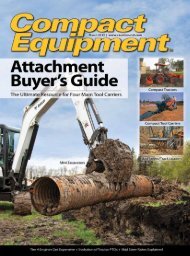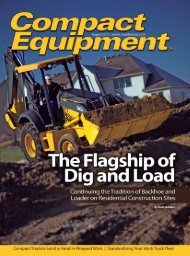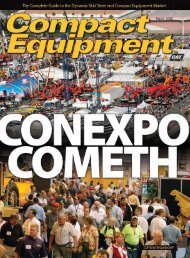CE EQUIPMENT CONNECTION - Compact Equipment
CE EQUIPMENT CONNECTION - Compact Equipment
CE EQUIPMENT CONNECTION - Compact Equipment
Create successful ePaper yourself
Turn your PDF publications into a flip-book with our unique Google optimized e-Paper software.
Tow to Tow<br />
One morning your skid steer is hauling dirt and gravel,<br />
the next afternoon it’s cold planing asphalt on a job across<br />
town. Versatility is what makes a skid steer such a popular<br />
and productive piece of equipment, but it’s also what makes<br />
it a machine on the move (to the next jobsite). While a<br />
commercial driver’s license is not needed to haul most skid<br />
steers, good towing and hauling practices are a prerequisite<br />
for owning such a mobile machine. Before you load up, strap<br />
down and roll off to your next skid steer job, be sure you<br />
follow the safe and smart guidelines below.<br />
1. Size the Machine and Trailer — Selecting the right trailer<br />
for the job always begins with identifying the dimensions,<br />
weight and loading characteristics of the piece of equipment<br />
you will be hauling. Today’s skid steers are classifi<br />
ed into nine categories by the Association of <strong>Equipment</strong><br />
Manufacturers (AEM). They’re classifi ed by rated operating<br />
capacity, which is 50 percent of the loader’s tipping<br />
load (tipping load is the capacity at which the rear wheels<br />
lift off level ground). Most skid steers fall into a wide range<br />
of operating capacities — from 600 to 3,700 lbs. But more<br />
important to your crews is the operating weight of the<br />
skid steer (the weight of the unit including tires, bucket, a<br />
full tank of gas and a 175-lb operator). Most skid steers fall<br />
between 4,000 and 9,900 lbs in operating weight.<br />
2. Hauling Attachments? — Along with your skid steer,<br />
you will need to contemplate what other attachments or<br />
accessories you will be carrying on the trailer. Backpack<br />
blowers? Cold planer attachments? Shovels? Bags of<br />
mulch? Take a backhoe attachment for instance — most<br />
weigh about 2,000 lbs. That extra weight will need to be<br />
added into the trailer formula. After you’ve assessed your<br />
average weight requirements for towing, you will need<br />
to fi nd a trailer with a corresponding GVWR, which is<br />
the gross vehicle weight rating. A 6,000-lb axle weight<br />
trailer, utilizing two 6,000-lb axles, has a GVWR of<br />
12,000 lbs. But then you have to subtract the weight of<br />
By Keith Gribbins, Managing Editor of <strong>Compact</strong> <strong>Equipment</strong><br />
the trailer and that would give you the weight of what<br />
you could haul.<br />
3. Add a Little Extra GVWR — Picking a GVWR that leaves<br />
about 1,500 lbs of excess payload is always a smart idea.<br />
That allows your driver greater margins in safety and<br />
fl exibility in what he or she is hauling that day. And it<br />
adds longer life for the components of the trailer (constant<br />
heavy loads will take their toll).<br />
4. Size the Sides — Along with choosing the best GVWR is<br />
making sure that the length and width of your trailer is<br />
suitable for your crew’s needs. Most skid steers range anywhere<br />
from 4 to 6 ft wide and 10 to 12 ft long, depending<br />
on the make and model, so size your trailer specs accordingly.<br />
Many machine owners go with 16-, 18- or 20-ft long<br />
trailer beds for their skid steer operations, always considering<br />
extra room for attachments. These trailers usually<br />
cost between $1,500 and $6,000 and that price tag gets<br />
even higher once options and hydraulic lifts are added.<br />
5. Getting Hitched — When looking for the right hitch, your<br />
main concern is the weight of the trailer and its payload.<br />
You have two weights to be concerned about here — gross<br />
trailer weight (GTW) and tongue weight (TW). GTW is the<br />
trailer weight plus its contents. The TW is the amount of<br />
weight applied directly on the ball. Once you know these<br />
two weights, you can choose the appropriate hitch in the<br />
right class (typically Class 3, 4 and 5 when considering<br />
skid steer towing). Just make sure your towing vehicle can<br />
handle that weight rating too.<br />
6. Chains and Thangs — Double check to make sure you’ve<br />
got safety chains and that you’ve got them hooked up.<br />
You’re better off to cross those chains, going underneath<br />
the tongue of the trailer diagonally, so that if anything does<br />
happen to the hitch, when the hitch drops, it catches on<br />
those crossed chains rather than digging into the ground.<br />
While a commercial driver’s license is not needed to haul most skid steers, good towing and hauling practices are a prerequisite<br />
for owning such a mobile machine. Most skid steers fall between 4,000 and 9,900 lbs in operating weight, so make sure<br />
you get a truck with a GVWR rating high enough to pull the combined weight of the skid steer and trailer.<br />
compactequip.com January 2008 <strong>Compact</strong> <strong>Equipment</strong> 21








